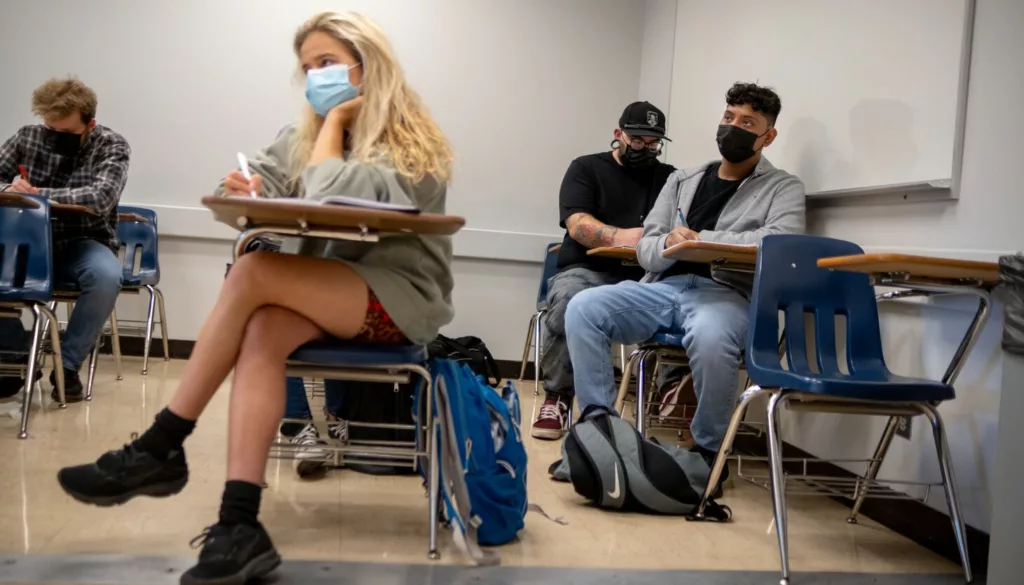[ad_1]
Group colleges observed enrollment commence to stabilize past slide after steep pandemic declines, fueled in aspect by additional new college students and a surge of dually enrolled substantial-schoolers, according to new data unveiled Thursday.
The figures from the Countrywide University student Clearinghouse get rid of more gentle on COVID-19’s sweeping effects on increased schooling, as establishments all around the nation now seek to climb out of deep enrollment troughs, and as knowledge reveals diverging developments throughout distinctive demographics.
Bucking a multi-year craze, in general enrollment at community faculties crept up by just less than 50 percent a % in the tumble — fundamentally flattening just after many years of slipping figures that predated even the pandemic. That alter arrived in portion thanks to a a lot more than 6% jump in new freshmen enrolling at neighborhood faculties nationwide, but continue to leaves the colleges perfectly under pre-pandemic norms. It is the initial time possibly pattern has greater in at least five yrs, according to the knowledge.
Doug Shapiro, executive director of the Countrywide Student Clearinghouse Research Heart, stated the figures supplied encouraging signs of restoration.
“Although freshmen classes are nevertheless nicely below pre-pandemic ranges, primarily at community schools, the fact that they are swinging upward in all sectors is a constructive indicator for the foreseeable future,” he claimed.
However, pandemic losses have been steep, and depressed enrollment figures go on to plague faculties across the nation — in particular at neighborhood schools. Undergraduate freshman enrollment fell by about 10% in 2020, but that quantity leapt to 17% when isolated to just community schools.
“It’s encouraging that there’s some rebound on new enrollment,” said John Fink, a community school researcher at Columbia University’s Teachers College. “But which is in the context of neighborhood schools currently being in a deep hole.”
He added losses have been notably severe between more mature older people and current large school graduates, with more and much more men and women deciding on either not to go to university or to go into 4-calendar year establishments.
“If you think about who local community schools provide, they’re open access institutions that provide area communities they enroll better shares of first-technology learners and minimal-cash flow pupils,” Fink mentioned. “So group university pupils are pretty delicate to external pressures, through operate obligations, relatives obligations, and fiscal obligations.”
Throughout the pandemic, “there had been a lot of elements pulling learners absent from local community faculties,” he claimed.
Even in advance of COVID-19, although, local community faculties have been viewing declines in enrollment for older older people and current substantial college graduates. At the exact time, group schools have expert explosive growth in substantial school pupils enrolling in their classes.
And twin enrollments fueled the stabilizing slide figures, too, looking at a 12% spike. Without the need of these students, overall enrollment at group schools fell nationwide by concerning 1.5% and 2%, in accordance to Shapiro.
“Certainly that would make a variation from a diploma-searching for viewpoint,” he mentioned. “[But] in the context of the health and fitness of the establishment, those people dual-enrollments do make a big difference.”
To Fink, the dually enrolled learners depict 1 path forward for local community schools, serving as a possible on ramp for their schools and some others.
“In several states, higher school pupils make up a quarter or a 3rd or additional of community higher education enrollment,” he reported. “What we’re hearing from schools is that about the many years as these systems have grown, occasionally there hasn’t been a whole lot of intentionality close to connecting the college’s mission of access and equity with the twin enrollment do the job.”
Investigate has discovered that such applications have been considerably less available to learners of shade and learners from lower-profits backgrounds, in spite of displaying favourable results for people who are able to take part, Fink extra. Faculties have started to strengthen their interactions with Title I schools and acquire other measures to bolster accessibility.
That operate can be specifically significant as data displays diverging enrollment tendencies for pupils of coloration.
Whilst Latino and Asian American learners saw enrollment figures commencing to rebound in the drop, Black and Indigenous American university student enrollment numbers declined more. People tendencies held constant across undergraduate enrollment as a full, and at neighborhood colleges in individual.
Enrollment traits outside of group colleges also began to stabilize, in accordance to the knowledge. All round, the nation’s undergraduate enrollment shrunk by just .6% in the slide, inspite of slipping by additional than 3% in every single of the prior pandemic many years. Nonprofit 4-calendar year schools also shifted by a fraction of a percent, though general public four-year colleges noticed a decline of about 1.4%.
“There’s however a lengthy way to go,” Shapiro reported. “But I think this is clearly an encouraging sign.”
Julian Shen-Berro is a reporter covering nationwide difficulties. Get in touch with him at [email protected].
[ad_2]
Resource website link
Meet Our Successful Graduates: Learn how our courses have propelled graduates into rewarding
careers. Explore their success stories here!
Discover More About Your Future: Interested in advancing your teaching career? Explore our
IPGCE, MA, and QTS courses today!

Explore Our Courses: Ready to take the next
step in your education journey? View our
comprehensive course offerings now!

